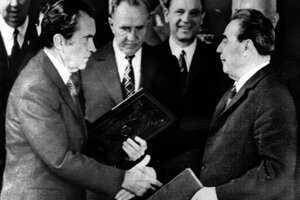US and Russian leaders meet and the world watches
With the much-anticipated meeting of President Trump and Russian President Putin on Friday, here's a look back at previous summits between leaders of the world powers.

Former President Nixon shakes hands with Communist Party leader Leonid Brezhnev in Moscow after the two signed a joint statement on May 29, 1972.
AP/File
Washington
When United States and Russian presidents meet, the rest of the world stops to watch.
For decades, summits between leaders of the world powers have been heavily anticipated affairs in which every word, handshake, and facial expression is scrutinized. President Trump's first face-to-face meeting with Russian President Vladimir Putin in Hamburg, Germany, on Friday is no different.
Some encounters have yielded diplomatic breakthroughs, even during the worst of Cold War tensions between the US and the Soviet Union. Others ended in unseemly displays of diplomatic discord.
A look at some of the US-Russian and US-Soviet summits of the past:
1945 – Yalta Conference
With World War II winding down, the leaders of the US, the Soviet Union, and Britain came together to plan for Europe's postwar future and try to hasten an end to the conflict in the Pacific. Soviet leader Josef Stalin agreed to enter the war to help defeat Imperial Japan. Former President Franklin D. Roosevelt and British Prime Minister Winston Churchill allowed for Soviet influence over lands Russia lost to Japan decades earlier.
Initially hailed as a major success, the conference later came to be viewed by many as the moment that the US ceded too much influence to the Soviets. Decades later, the setting for the meeting – Crimea – would provide some irony. Russia, the Soviet Union's successor, annexed the region from Ukraine in 2014, deepening a modern-day diplomatic rift with the US.
1960 – Paris
This Cold War meeting between former President Eisenhower and Soviet leader Nikita Khrushchev may have been doomed from the start. Two weeks before they were to gather in Paris, the Soviets shot down an American U-2 spy plane. The US tried to cover it up by claiming it was a weather-monitoring plane, a lie the Soviets were able to expose.
Mr. Khrushchev ripped into Mr. Eisenhower at the meeting, infuriating the US president. Eisenhower ended up canceling a trip to Moscow planned for the following month.
1961 – Vienna Summit
The two-day meeting was the first between Khrushchev and former President Kennedy, almost two decades Khrushchev's junior. There was plenty of fanfare, including a high-profile interaction between first ladies Nina Khrushchev and Jacqueline Kennedy.
But US government accounts of the summit suggest it was extremely tense. Kennedy was largely steamrolled by the Soviet leader, who demanded an immediate treaty to reunify Germany under terms unfavorable to the US. The collapse raised the specter of an actual war between the two nuclear-armed foes. Two months later, the Berlin Wall went up.
1972 – Moscow Summit
Former President Nixon flew to the Soviet capital, the first visit to Moscow by a sitting US president, for a week of meetings with Soviet leader Leonid Brezhnev. It was productive, to say the least.
Not only did the two leaders clinch a pair of major agreements limiting ballistic missiles and slowing the nuclear arms race, they also struck smaller deals on education, science, maritime coordination, and public health. The agreements were touted at a signing ceremony that would later be viewed as an inflection point in the Cold War.
1986 – Reykjavik Summit
Another breakdown between leaders, this time in the Icelandic capital. Hastily arranged with low expectations, the summit grew in scope to the point it appeared a major arms reduction deal might be reached.
The summit produced iconic photos of former President Reagan and Soviet leader Mikhail Gorbachev smiling together at Hofdi House in Reykjavik, but not much else. The leaders failed to strike a deal, or to settle on a date for a follow-up summit in the US.
2001 – Slovenia Summit
A decade after the fall of the Soviet Union, former President George W. Bush famously looked into Russian President Vladimir Putin's eyes. "I was able to get a sense of his soul – a man deeply committed to his country and the best interests of his country," Mr. Bush said afterward.
Bush went as far as to invite Mr. Putin to visit his ranch in Crawford, Texas.
2012 – G20 Seoul Summit
It's easy to pinpoint the moment former President Obama learned the risks of an open microphone once and for all: March 2012, in Seoul, South Korea. That's where the first-term president was caught telling Russian President Dmitry Medvedev that if re-elected, he would "have more flexibility" to work out missile defense issues with Moscow.
Mr. Medvedev famously replied by telling Mr. Obama he would "transmit this information to Vladimir" – referring to Putin, who was nearing the end of a four-year stint as Russia's prime minister. Obama's Republican opponent, Mitt Romney, quickly seized on the gaffe as evidence Obama was concealing a secret agenda for his second term.
2016 – G20 Hangzhou Summit
Obama's last formal sit-down with Putin was no farewell fete. He had kicked Russia out of the Group of Eight club of industrialized nations over its actions in Ukraine, and his relationship with Putin never recovered. Their 90-minute session during a global summit in Hangzhou, China, was a chilly affair, captured in awkward photographs in which neither man broke a smile.
There was no breakthrough on Syria, where the US and Russia were hoping for a deal to lower violence. And a growing American sense about Russian meddling in the US presidential campaign cast a pall over their meeting. The next and last time Putin and Obama would meet, it would be for only four minutes on the sidelines of an economic conference in Peru.

